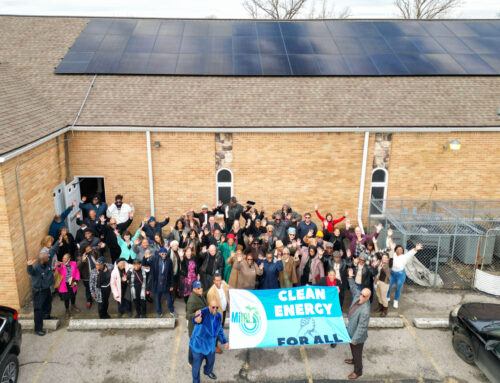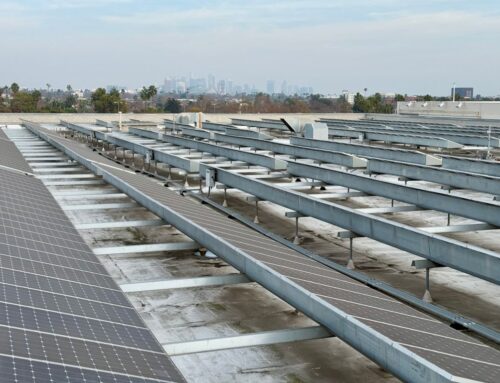Climate and environment updates: EV sales are surging globally despite US pullback
May 14, 2025
The climate crisis is not a distant threat; it’s happening right now and affecting what matters most to us. Hurricanes intensified by a warming planet and drought-fueled wildfires are destroying our communities. Rising seas and flooding are swallowing our homes. And record-breaking heat waves are reshaping our way of life.
The good news is we know how to turn the tide and avoid the worst possible outcomes. However, understanding what needs to be done can be confusing due to a constant stream of climate updates, scientific findings and critical decisions that are shaping our future.
That’s why the ABC News Climate and Weather Unit is cutting through the noise by curating what you need to know to keep the people and places you care about safe. We are dedicated to providing clarity amid the chaos, giving you the facts and insights necessary to navigate the climate realities of today — and tomorrow.
Latest Developments
Despite the Trump administration’s desire to roll back incentives, adoption goals and funding for electric vehicle (EV) programs and charging stations in the United States, there appears to be no stopping the forward momentum of EV sales throughout the world.
According to a new analysis by the International Energy Agency (IEA), EV sales will account for one-quarter of the new cars sold worldwide by the end of 2025. The IEA says electric car sales will surpass 20 million units. That would mark a significant increase over 2024 when customers purchased 17 million EVs.
China continues to lead the world when it comes to EV adoption. Nearly half of all the cars sold last year in China were electric. The country can now boast that 1 in 10 cars on the road is an EV. Electric vehicle sales grew by nearly 10% in the United States, but the IEA anticipates a slowdown in EV adoption in the U.S. due to what the agency calls “today’s policy direction.” The agency significantly slashed its estimate for U.S. EV sales by more than half compared to last year. The IEA now forecasts that the sales share of EVs in the U.S. will grow by 20% by 2030.
But it’s a very different story across the globe. The IEA anticipates that more than 40% of cars sold worldwide will be electric by 2030. China is expected to hit 80%, and Europe’s share should be close to 60%. The IEA says Asia and Latin America are also becoming the new centers of growth for EV sales and adoption, accounting for 40% of global new vehicle sales.
In terms of charging, the IEA says it’s a mixed bag. While public charging stations have doubled globally in the last two years in the U.S. and the United Kingdom, the agency says public charger build-outs are not keeping pace with EV adoption. In comparison, the report cites China and the European Union as two regions that are keeping up with charger deployment and construction.
The IEA says the shift from gas-powered cars and trucks to EVs means the world will need less oil. By 2030, battery-powered EVs are expected to replace more than 5 million barrels of oil per day. However, they warn that lower gas prices could affect EV sales, as could potentially higher electric vehicle prices resulting from tariffs.
-ABC News’ climate and weather unit’s Matthew Glasser
More than 60 years have passed since the first satellite was launched into space, sparking an international space race that brought historic missions and a dramatic rise in the number of objects circling our planet. Today, we rely on thousands of satellites for communication, navigation and research. But as their numbers continue to skyrocket, so do concerns about the growing volume of space debris and its potential impacts.
The number of satellites in low Earth orbit, where most are found, is expected to surge in the coming years, growing from thousands to tens of thousands over the next 15 years, according to the Government Accountability Office. While most of these satellites burn up as they plummet back to Earth, some of the particles they leave behind in the atmosphere could have lasting effects as their numbers increase.
Falling pieces of space debris often attract attention, but little is known about the aerosols produced during reentry vaporization and their impacts on Earth’s atmosphere. For example, aluminum, one of the most widely used materials in satellite construction, vaporizes during reentry and forms alumina particles, which can accumulate in the atmosphere.
A recent study in the Journal of Geophysical Research: Atmospheres explored what some of these impacts might be and when they could begin to have a notable effect. Researchers simulated how clouds of alumina vapor could impact Earth’s middle and upper atmosphere, finding that the amount of alumina from plummeting satellites would eventually be significant enough to alter conditions in the stratosphere and mesosphere, which are both part of the middle atmosphere.
According to the study, by 2040, there could be enough alumina in the stratosphere to influence temperatures and wind speeds in the polar regions, potentially affecting both the ozone layer and the polar vortex over the Arctic and Antarctic. Their results show alumina particles could heat the middle atmosphere near Earth’s poles by about 1.5 degrees Celsius, potentially reducing wind speeds in the Southern Hemisphere’s polar vortex by about 10 percent.
Previous research has shown that a weaker polar vortex in the Southern Hemisphere can promote warmer and drier weather conditions across eastern Australia, increasing the threat of dangerous wildfires during the spring and summer months.
Researchers speculate this may also help shrink the ozone hole over the South Pole each year, though the precise relationship between alumina and ozone chemistry remains unclear. Researchers note that some reentry scenarios also showed the opposite effect in the Northern Hemisphere, with possible strengthening of the polar vortex.
While more research is needed to fully understand how increasing space debris may affect Earth’s weather and climate, this study underscores the importance of investigating these potential impacts as our gateway to space becomes increasingly crowded.
-ABC News meteorologist Dan Peck
April 2025 was the second-warmest April on record globally, just behind April 2024, according to new data analyzed by the Copernicus Climate Change Service. Earth’s average surface air temperature was 58.93 degrees Fahrenheit.
While the planet may have fallen a little short of breaking another record, global temperatures once again exceeded the 1.5-degree Celsius warming threshold established in the 2015 Paris Climate Agreement, coming in at 1.51 degrees Celsius above the pre-industrial reference period (1850 to 1900).
Last month marked the 21st of the previous 22 months to exceed the warming threshold identified by climate scientists as a critical limit to reduce the worst risks and impacts of human-amplified climate change. While this is a troubling trend, exceeding the threshold temporarily is not seen as a failure to limit global warming, as climate averages are analyzed over several decades.
Antarctic sea ice extent was 10% below average for the month. In the Arctic, the report found sea ice extent was 3% below average, marking the sixth-lowest April extent on record. The Arctic region is warming significantly faster than the global average and, after serving as a carbon sink for thousands of years, has become a source of carbon dioxide emissions due to rapidly rising temperatures and increased wildfire activity, according to the National Oceanic and Atmospheric Administration.
Global daily sea surface temperatures across much of the world’s oceans remained well above average in April. Between the latitudes of 60 degrees south and 60 degrees north, the average global sea surface temperature was 69.6 degrees Fahrenheit, the second-highest value on record for the month, according to Copernicus.
Unusually, warm sea surface temperatures could play a key role in tropical cyclone development during the upcoming Atlantic hurricane season, which begins on June 1. NOAA is expected to release its official outlook for the upcoming season on May 22.
-ABC News meteorologist Dan Peck
As carbon dioxide levels in Earth’s atmosphere reach record highs and the effects of human-amplified climate change intensify, climate scientists are urgently searching for effective ways to slow global warming. Rapidly reducing atmospheric levels of CO2, a heat-trapping greenhouse gas, is one of the most critical challenges, and in many cases, nature can be part of the solution.
Hidden along the world’s coastlines and just beneath the ocean’s surface, seagrass meadows are among the most threatened and one of the most overlooked ecosystems on the planet. But they could play an essential role in fighting climate change thanks to their remarkable ability to absorb and store carbon, according to a new study published in Nature Communications.
Although they cover only about 0.2% of the ocean floor, seagrass meadows store a significant portion of the ocean’s carbon, accounting for roughly 10% of its total carbon storage capacity. Seagrass absorbs CO2 up to 35 times faster than tropical rainforests, according to the United Nations Environment Programme.
In the largest study of coastal ecosystems to date, researchers analyzed over 3,000 samples of seagrass and soil from 61 countries, revealing significantly greater variation in carbon storage among species and regions than previously understood.
“Seagrass meadows are not just important for marine biodiversity, they are a critical piece of the climate puzzle,” said lead author Johannes Krause, a researcher at Conservation International and assistant research professor at Florida International University. “This research underscores their vast potential as carbon sinks and the importance of accurate data to ensure we’re protecting them properly.”
Researchers say that protecting and restoring seagrass meadows is a promising yet underutilized climate mitigation tool. Greater investment and research on these ecosystems can help preserve biodiversity and strengthen the planet’s natural ability to store carbon.
Protecting vegetated coastal ecosystems, like seagrass meadows, could prevent the release of 1.2 billion metric tons of CO2 into the atmosphere, the equivalent of removing the annual carbon footprint of 100 million homes in the United States, according to the nonprofit Conservation International, which funded the study. Researchers also estimate this could avoid more than $200 billion in climate change-related costs through 2050.
-ABC News meteorologist Dan Peck
For the first time, a new study finds climate change is now the primary driver of biodiversity loss in the United States.
Researchers examined the five predominant threats facing 2,766 imperiled species in the U.S. Those are plants and animals that have significantly declined in numbers and are at high risk of extinction.
The team from the Center for Conservation Innovation at Defenders of Wildlife found when they applied climate change assessments to the plants and animals on the U.S. Endangered Species Act list, climate change was the most far-reaching biodiversity threat, impacting 91% of ESA-listed species.
While climate change may be the most common threat, it’s not the only one. Changes to land and sea ecosystems, such as land conversion, pollution and resource extraction, was the No. 2 most common at 90%. Other primary drivers of biodiversity loss include overexploitation, invasive species and pollution.
These five threats often overlap. The researchers found that 86% of all U.S. imperiled species faced two or more threats. On average, those on the ESA list faced nearly three of the five threats. And the researchers found a species’ habitat largely impacts its risks. Marine species, for example, face the highest number of threats.
“With the biodiversity and climate crises deeply intertwined, not only is addressing climate change necessary for imperiled species, but protecting biodiversity and supporting healthy ecosystems is also essential to shifting our climate trajectory,” the authors wrote in the study.
– ABC News Weather and Climate Unit’s Matthew Glasser
The government organization responsible for forecasting hurricanes and keeping people safe during these deadly and destructive storms set a new record for forecast track accuracy in 2024. But recent budget and staffing cuts by the Trump administration could jeopardize this progress.
Part of the National Oceanic and Atmospheric Administration, the National Hurricane Center played a crucial role in helping people prepare through timely and accurate forecasts. NHC issued 347 official forecasts during the 2024 Atlantic hurricane season, and its track predictions set accuracy records for every time period, according to a new report released on Wednesday.
Track forecast performance, which details the path a storm will take, was the best in history for the agency. Official track forecast errors have decreased significantly in recent years and are now up to 75% smaller than they were a few decades ago, according to the report.
The report also analyzed intensity forecast accuracy, which continues to lag behind track forecasts. However, the report said overall intensity predictions have shown steady improvement over the past decade.
NOAA and several key divisions, like the National Weather Service and National Hurricane Center, have been impacted by recent staff reductions approved by the Trump administration. According to current and former NOAA employees who spoke to ABC News, these cuts are impacting offices that are already coping with inadequate staffing levels.
Staffing limitations have impacted several key services provided by the National Weather Service, including reducing weather balloon launches at select sites nationwide. With fewer upper-air observations, less data is available for the weather models that forecasters rely on.
NOAA and the United States Air Force operate aircraft, commonly called the Hurricane Hunters, which fly into tropical cyclones to collect data essential for forecasting a storm’s path, timing and strength. According to a March report from the Government Accountability Office, these vital missions have also faced staffing and maintenance challenges in recent years, which has resulted in canceled flights.
Hurricane Hunter flights provide critical meteorological data from inside the storms, a necessary component for producing detailed tropical cyclone forecasts. NOAA research shows that their collected data improves hurricane forecast accuracy by at least 10%. The more high-quality data that forecasters have at their disposal, the more effectively they can develop precise and detailed forecasts.
-ABC News meteorologist Dan Peck
It’s been more than 50 years since the first Earth Day in the United States. On April 22, 1970, people gathered at events across the country to raise awareness about the environmental issues impacting our nation and the planet. While the Earth Day movement has helped raise awareness about human-amplified climate change and has led to some regulatory actions, 5 1/2 decades later, the planet continues to warm at an alarming rate, with the impacts of that warming worsening with each passing decade.
Climate scientists have long recognized that increasing levels of carbon dioxide and other greenhouse gases that trap heat in the atmosphere contribute directly to global warming. There is a strong and well-established link between rising global temperatures and extreme heat events as a result of human-induced climate change.
Since the first Earth Day, the annual average concentration of carbon dioxide in the atmosphere has increased by more than 30%. It is now rising at the fastest rate on record, according to the National Oceanic and Atmospheric Administration.
All 50 states and 240 cities across the U.S. have experienced warming since the first Earth Day, according to an analysis by Climate Central, a nonprofit climate research group. Alaska has warmed the fastest, followed by Delaware, Massachusetts and New Jersey.
The Arctic region is heating much faster than the global average, which has pushed Alaska to the top of the list, with its average annual temperature rising by 4.3 degrees Fahrenheit since 1970. Among cities, the fastest-warming over the past 55 years include Reno and Las Vegas in Nevada, El Paso and Tyler in Texas and Burlington, Vermont.
Overall, the contiguous United States is now about 2.8 degrees Fahrenheit warmer than it was in 1970, based on average annual temperatures.
Warming global temperatures are also driving sea-level rise, which has been accelerating in recent decades due to melting glaciers and ice sheets, as well as the thermal expansion of seawater as it warms.
Since 1970, sea levels have risen by more than half a foot, on average, across the contiguous United States, according to the Interagency Task Force on Sea Level Change. Some regional coastlines, states and cities have experienced even greater increases. Sea-level rise varies regionally along the nation’s coastlines due to shifts in both land elevation and ocean height.
The Northeast coastline, for example, has recorded an average increase of 9 inches since 1970. Florida has seen a rise of 7 inches over the past 5 1/2 decades, while in Washington, D.C., the sea level is now 8 inches higher than in 1970.
-ABC News meteorologist Dan Peck
Artificial intelligence is growing at a meteoric rate, requiring a larger share of the world’s energy. Powering AI is a vast infrastructure of data centers, cloud networks and computing systems that are fueling a growing energy demand.
In a first-of-its-kind comprehensive report on AI and energy, the International Energy Agency said the global expansion of AI data centers is likely to drive some of the fastest growth in global electricity demand seen in recent years.
“With the rise of AI, the energy sector is at the forefront of one of the most important technological revolutions of our time,” IEA Executive Director Fatih Birol said.
The IEA projects electricity demand from global data centers will more than double over the next five years and, by 2030, consume as much as the nation of Japan does today.
According to the report, data centers in the United States are likely to account for almost half of the growth in electricity demand. The report emphasizes that by 2030, the U.S. economy will use more electricity for data processing than for producing all energy-intensive goods combined, such as steel, aluminum, cement and chemicals.
Despite concerns over rising global energy demand, the IEA said their analysis shows positive impacts, like increased productivity, enhanced competitiveness and cost reductions, could outweigh the negative effects. In fact, the growth of AI in the energy sector could even help reduce global energy-related emissions, a reduction that could be far larger than new emissions from data centers, the report found.
While a mix of energy sources will be needed to meet the world’s growing data center electricity demands, renewable sources are expected to supply roughly half of the global demand growth over the next five years, according to the report. Data centers may also serve as hubs for new low-emission energy projects. And as AI becomes more integrated into scientific research, the IEA said it could help accelerate innovation in energy technologies such as batteries and solar PV.
For example, leaks are a significant source of methane emissions in oil and gas production. The report said AI can facilitate rapid leak detection so that repairs happen sooner, limiting total emissions. AI could also help reduce transportation-related emissions by choosing the most efficient travel routes in real time, according to the report.
-ABC News meteorologist Dan Peck
It has been an active start to the severe weather season. According to a new report from the National Oceanic and Atmospheric Administration, U.S. tornado activity in March was more than twice the monthly average, with over 200 tornadoes recorded.
This trend continued through the first week of April, with more than 150 tornado reports across the South and Midwest during a devastating multi-day stretch of life-threatening weather conditions.
The report also highlighted notable temperature and precipitation trends nationwide in March. Last month, the average temperature of the contiguous U.S. was 46.9 degrees Fahrenheit, more than 5.4 degrees Fahrenheit above average. That ranked last month as the nation’s sixth warmest March on record. Above-average to way above-average temperatures were observed across most of the Lower 48, except for parts of California and the Southeast.
Precipitation was below average across much of the Plains and South in March, which brought expanding and intensifying drought conditions to states like Texas, Oklahoma and Kansas. Persistently dry conditions also kept a drought in place across much of the Carolinas, fueling the destructive wildfires that ravaged both states last month.
North Carolina experienced its driest March since 2016, and South Carolina has had its driest first three months of the year in nearly 40 years. The extremely dry conditions were a primary contributor to the rapid spread of the flames, which was exacerbated by the millions of downed trees in the region due to Hurricane Helene last fall. This created an abundance of dry fuel, allowing wildfires to explode in size. Drought conditions are likely to persist across the Carolinas through the end of the month.
According to the latest U.S. Drought Monitor report released on April 1, about 43.4% of the contiguous U.S. is experiencing drought.
-ABC News meteorologist Dan Peck
Last month was the second-warmest March on record globally, according to new data analyzed by the Copernicus Climate Change Service (C3S). And once again, the planet exceeded 1.5 degrees Celsius, as established by the 2015 Paris Climate Agreement, coming in slightly above that at 1.6 degrees Celsius above the pre-industrial average (1850-1900).
Last month marked the 20th of the previous 21 months to exceed the warming threshold established in the Agreement. The 1.5-degree ceiling was established because scientists and international climate organizations say limiting global temperatures to that level significantly reduces the risks and impacts of climate change.
It is important to note that exceeding the 1.5 degree Celsius threshold temporarily is not seen as a failure to limit warming under the Agreement since it looks at the climate average over multiple decades. Still, the trend is concerning.
The planet may have fallen just short of breaking another global temperature record for March, but Europe soared to a new record. The March average temperature over that continent was 2.41 degrees Celsius, or 4.34 degrees Fahrenheit, above the 1991-2020 average for the month, making it the warmest March on record.
Globally, the average surface air temperature was 14.06 degrees Celsius, or 57.31 degrees Fahrenheit.
Global daily sea surface temperatures across most of the world’s oceans remain well above average, including across the Atlantic Basin. The report found that the average global sea surface temperature for March 2025 was 69.73 degrees Fahrenheit, the second-highest value on record for the month.
Unusually warm sea surface temperatures could once again play a major role in tropical cyclone development during the upcoming Atlantic Hurricane Season, which begins on June 1. The National Oceanic and Atmospheric Administration will release its official outlook for the forthcoming season later next month.
Arctic sea ice extent dipped to its lowest value on record for the month of March at 6% below average. This was the fourth straight month with record-low ice cover for the corresponding month. Antarctic sea ice extent was 24% below average for the month, according to Copernicus.
-ABC News meteorologist Dan Peck
Search
RECENT PRESS RELEASES
Related Post




